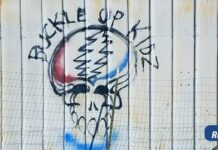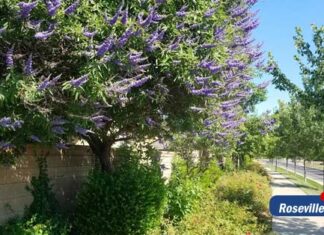Rocklin, Calif. – The pyramid-shaped Whitney family tomb is an often photographed curiosity near the 11th green of the Whitney Oaks Golf Course.
History doesn’t record the tomb’s construction date but one family member theorizes that Lucy Chadwick Whitney prepared it for her husband, Joel Parker Whitney, called Parker then, a few months before he died of kidney disease in 1913.
The family opens and reseals the tomb periodically, most recently in May 2006, and today it contains the cremated remains of 17 family members and close friends. Nine of these people had little, if any, impact on Rocklin’s history or operations of the Whitney Ranch.
But these eight were known in Rocklin and, because of Parker’s wealth and influence, were celebrities of their times.
George Whitney, (1801 1885) and his wife Sophia Whitney, (1807 1888) were Parker’s parents. George ran a special breed of sheep on open Placer County rangeland in the mid 1850’s and established the Whitney Ranch, later known as the Spring Valley Ranch, in 1857 with the purchase of 320 acres near Rocklin. George ceded control of the ranch to Parker in the early 1870’s. The presence of George and Sophia indicates that the family might have constructed the tomb as early as the mid 1880’s.
Joel Parker Whitney (Parker), (1837 1913) was wealthy by his mid 30’s, mainly from investments in Colorado mines and real estate. He acquired control of the Whitney Ranch from his father George in the early 1870’s and expanded it to 27,000 acres by bringing water from the Bear River watershed and diversifying ranch activities. He befriended the native Nisenan and documented their life ways, built the Oaks mansion in the mid 1880’s and founded the Placer County Citrus Colony in the late 1880’s. Rocklin’s northern and western development since the early 1960’s has been mostly on the southern 12,000 acres of Parker’s Ranch.
J. Parker Whitney (1878 – 1924) was oldest of Parker’s three children, often confused by writers with his father because both went by ‘Parker’. He was a bon vivant and a scoundrel known in Rocklin prominently for his frequent forays at Porter’s saloon. He once paid a girlfriend $2, 500 to drop charges that she had brought against him under a white slavery law after he had jilted her for another girlfriend, all of this during the last years of his marriage to the first of his three wives, wealthy socialite Daisy Parrott.
J. Parker managed the ranch at the turn of the century but eventually lost control to his brother Vincent. One family member credits J. Parker’s poor management skills and irresponsible lifestyle with the start of the decline of the Whitney Empire.
Katherine (Kate) Gorby Whitney (1886 1939) was J. Parker Whitney’s third wife. J. Parker died four months after the marriage in 1924, but his estate supported Kate and her children from a previous marriage until 1939. Kate and J. Parker once occupied the Gorby family home, later famously the Hebuck home, next to the original site of the Catholic Church on Front Street.
Lucy Ann Chadwick Whitney (1847 1926) was Parker’s third wife and the mother of his only three children, J. Parker, Vincent, and Helen Beryl. She married Parker in 1881 at Saint Paul’s Church across the street from Capital Park in Sacramento after Vincent’s birth. Lucy fought her children bitterly over Parker’s will, losing out to her son Vincent and eventually winning only a small increase in her monthly allotment.
Helen Beryl Whitney (1884 1935) was the youngest of Parker’s three children. She grew up during the halcyon days of Parker’s Placer Citrus Colony and twice appeared promoting the colony in Sunset Magazine, once on the cover. She eloped from college with Harvard football star Thomas Graydon in 1904 and graced newspaper scandal sheets through three ensuing marriages and divorces. She apparently was never a factor in ranch affairs and finances, but Rocklin old-timers remember that she once operated a restaurant in downtown Rocklin. She was the last of Parker’s descendents to occupy the Oaks.
Vincent Whitney (1880 1966) was Parker’s second son, a San Francisco Insurance Broker who wrested control of the Whitney Estate from his mother and siblings after his father’s death and sold off ranch assets during the early and mid 20th century.
Sam Edwards was a family gardener, and evidently a favored servant because a tiny plaque inside the tomb indicates that Sam’s remains are buried in an unmarked grave outside the tomb. Step carefully when you visit.
(21+ years strong)
Welcome to the brighter side!
Get in front of local customers! 24/7 (365)





















